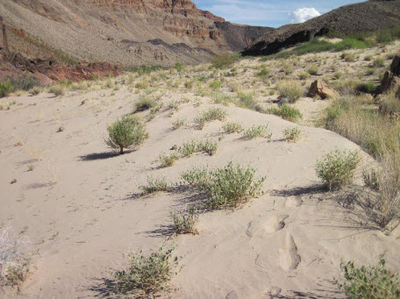Updates
|
|
|
How many cultural sites are affected by aeolian sand transport?
|
|
Of 358 river-corridor arch sites (RM 0-240), 76 (21%) are adjacent and upwind of sandbars receiving HFE sand and don't have some sort of topographic barrier between the sandbar and the arch site (Type 1 and Type 2a). Of these, 44 sites (12%) are currently blocked by vegetation from receiving aeolian sand. [2]
|
|
Links
|
|
|
Stakeholder Questions
|
- Does aeolian sand transport research support the use of sand bar building from HFEs as a means to provide a source of aeolian sands to preserve and protect archaeological sites?
|
Presentations and Papers
|
|
2020
2019
2018
- GCMRC Science Updates PPT
- Kasprak et al., 2018, Quantifying and forecasting changes in the areal extent of river valley sediment in response to altered hydrology and land cover: Progress in Physical Geography: Earth and Environment
- Solazzo, D., Sankey, J.B., Sankey, T.Ts., Munson, S.M., 2018. Mapping and measuring aeolian sand dunes with photogrammetry and LiDAR from unmanned aerial vehicles (UAV) and multispectral satellite imagery on the Paria Plateau, AZ, USA: Geomorphology, v. 319, p. 174-185
- Sankey et al., 2018, The response of source-bordering aeolian dunefields to sediment-supply changes 1--Effects of wind variability and river-valley morphodynamics: Aeolian Research
- Sankey et al., 2018, The response of source-bordering aeolian dunefields to sediment-supply changes 2--Controlled floods of the Colorado River in Grand Canyon, Arizona, USA: Aeolian Research
2017
2016
2015
2014
2013
2012
2010
|
Other Stuff
|
|
Collin et al. 2016:
- Aeolian deposition was found at 4 sites (30%) where partial infilling occurred preventing further erosion.
- “Despite this promise for archaeological site preservation, our observations show that gully annealing can only occur under a specific set of conditions related to fluvial sand availability and wind transport direction.”
- "In this study, aeolian deposition, even with anthropogenic forcing via fluvial sand-bar building high flow dam releases, was found to be generally insufficient to offset the effects of precipitation-induced gullying."
East et al. 2016:
- The problem: Landscapes downstream from Glen Canyon Dam contain archaeological resources that are affected by fluvial (river), aeolian (wind), and hillslope (gravity and rainfall-runoff) geomorphic processes.
- The question: Can Colorado River sediment enhance the preservation of river corridor archaeological resources in these landscapes through aeolian sand deposition and mitigation of gully erosion?
- The results: Relatively few archeological sites are now ideally situated to receive aeolian sand supply from sandbars deposited by recent controlled floods (HFEs) from Glen Canyon Dam (decreased from 98 sites in 1973 to 32 in 2012).[3]
|
|


